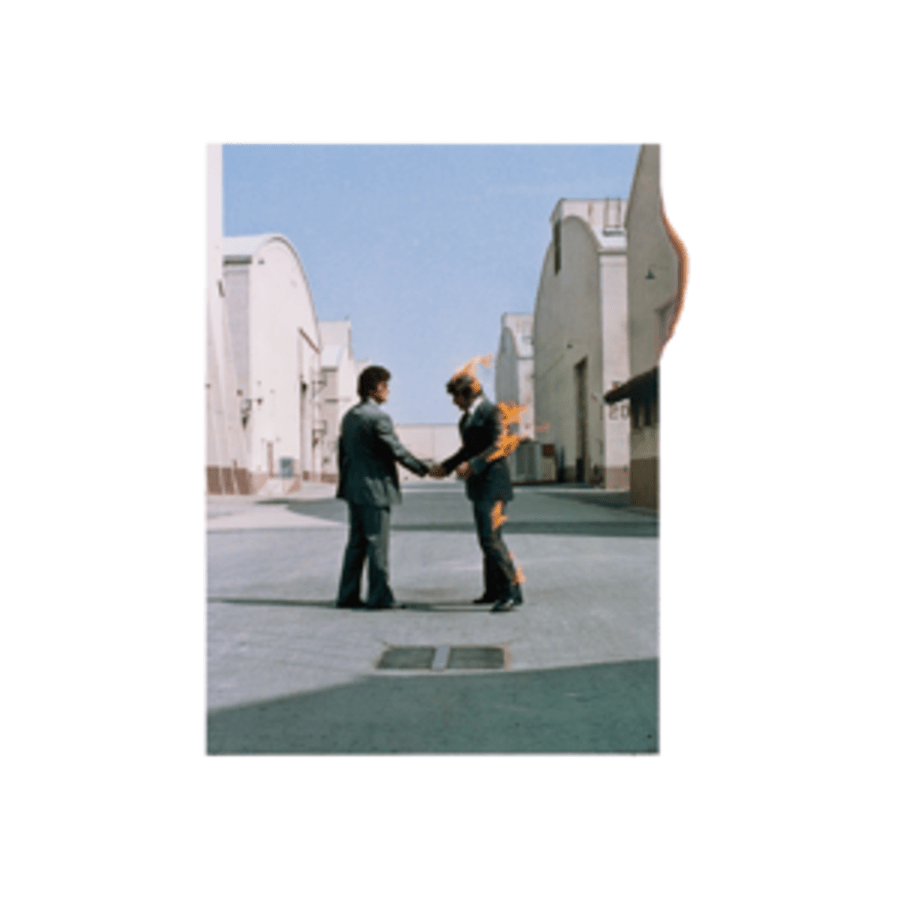Surrealism, a revolutionary movement born in the early 20th century, emerged as a bold defiance to conventional perceptions of reality. Inspired by the psychoanalytic work of Freud, surrealists sought to bridge the gap between the conscious and the subconscious, creating a super-reality where dreams and the everyday world coalesced into a singular, often bizarre visual language. Artists like Salvador Dalí and René Magritte painted canvases filled with melting clocks and levitating men in bowler hats, challenging observers to question the nature of reality itself.
Into this world of surrealism, where the line between the dream-state and reality blurred, Storm Thorgerson stepped with a camera, a keen graphic design sense, and a profoundly musical pulse. Born in England in 1944, Thorgerson would become synonymous with some of rock and roll’s most iconic album covers, translating the auditory complexities of music into visually arresting artwork that captured the essence of each album’s sound in unimaginably vivid ways.
Storm Thorgerson’s tenure as a visual maestro can perhaps be most distinctively seen through his work with Pink Floyd, whose psychedelic soundscapes found their visual counterpart in Thorgerson’s designs. However, his influence wasn’t just confined to one band; his portfolio spans an impressive list of rock and roll’s elite, from Led Zeppelin to Muse. Each piece of art not only enhanced the listener’s experience but also deepened the connection between the music and its audience, often becoming as legendary as the albums they graced.
Early Life and Influences

Storm Thorgerson was born in Potters Bar, Middlesex, England, in 1944. From an early age, Thorgerson displayed an acute sensitivity to visual and auditory stimuli, a trait that would later define his career. He was educated at the prestigious Summerhill School and later at the Royal College of Art, where he studied English and Philosophy before transitioning to Film and Television. This multidisciplinary education not only honed his artistic sensibilities but also ingrained a deep appreciation for narrative depth, which became a hallmark of his album covers.
The 1960s were a vibrant period for artistic experimentation, marked by a spirit of rebellion and the breaking of traditional boundaries in both visual art and music. It was during these formative years that Thorgerson’s path crossed with the members of what would become one of the most influential bands in rock history, Pink Floyd. Attending Cambridgeshire High School for Boys alongside Syd Barrett and Roger Waters, Thorgerson was deeply embedded in the musical and cultural shifts of the time. His close friendships with the band members provided a unique insight into the music’s inner workings, allowing him to create album covers that were true extensions of the sound and philosophy of the music itself.
Influence and Artistic Vision
Influenced by surrealists like Dalí and Magritte, Thorgerson’s approach to album art was revolutionary. He was drawn to surrealism’s emphasis on unlocking the subconscious, using symbolism and dream-like imagery to evoke complex emotions and ideas. This alignment with surrealism was not just aesthetic but philosophical, embracing the movement’s disdain for the conventional and its quest for deeper meaning.
Thorgerson’s artistic vision was also shaped by his exposure to the burgeoning rock scene of London and the countercultural wave sweeping across the globe. The late 1960s and early 1970s were a time of musical exploration, social upheaval, and radical changes in public consciousness, all of which influenced Thorgerson’s work. His designs often mirrored the era’s ethos—challenging perceptions, confronting norms, and pushing the boundaries of what album art could represent.
Moreover, Thorgerson’s involvement in the graphic art group Hipgnosis, which he co-founded with Aubrey Powell, was instrumental in his development as an artist. Hipgnosis became synonymous with innovative, sometimes surreal album covers, producing memorable art for a wide array of artists beyond Pink Floyd, including T. Rex, Led Zeppelin, and Peter Gabriel. This collaborative environment fostered creativity and pushed Thorgerson to explore the intersection of photography, graphic design, and fine art, setting the stage for some of the most iconic visuals in rock music history.
The Genesis of a Surrealistic Style in Album Art
Storm Thorgerson’s foray into the world of album art is a narrative steeped in the creative ferment of the 1970s, a period when rock and roll was not just heard but increasingly seen. His transition into album art was marked by an iconic commission: Pink Floyd’s “The Dark Side of the Moon.” This project not only solidified his reputation as a pioneering album artist but also set the tone for his future works, blending surrealism with an almost clinical precision in execution.
The Dark Side of the Moon: A Case Study

The cover of “The Dark Side of the Moon” (1973) is a masterpiece of minimalism and metaphor, featuring a simple prism dispersing light into color. This design, while seemingly straightforward, carried profound symbolic weight, representing the band’s lighting and the album’s themes of madness, greed, and transformation. Thorgerson’s concept, driven by the band’s sonic exploration and philosophical lyrics, transcended traditional cover art by linking visual art and music through a shared language of abstraction and symbolism.
Defining Characteristics of Thorgerson’s Style
Thorgerson’s style is distinguished by its surreal, dream-like quality, where the ordinary becomes extraordinary. He often employed a technique of placing everyday objects in stark, unusual contexts, creating a sense of alienation and intrigue. His covers do not merely represent the music; they interpret it, drawing on themes from the albums to inform the visual narrative. This approach demands an engagement from the viewer, turning the album cover into an interactive experience that complements the auditory one.
A notable example is his cover for Led Zeppelin’s “Houses of the Holy,” which features a group of mysterious, golden-haired children climbing the Giant’s Causeway. This enigmatic image perfectly encapsulates Thorgerson’s ability to combine natural landscapes with human elements to create a surreal and captivating visual story that echoes the mystical qualities of the album’s music.
Technical Aspects of Thorgerson’s Photography and Graphic Design
Technically, Thorgerson’s work is characterized by its pioneering use of photography. Before the digital age, his techniques involved intricate setups and natural effects, often requiring complex shoots that were both logistically challenging and artistically demanding. He preferred to create his effects in-camera rather than through post-production, a testament to his commitment to ‘pure’ photography.
His use of bold colors, dramatic lighting, and careful composition became signatures of his work. Thorgerson’s skill in graphic design—particularly his manipulation of scale and mastery of visual puns—allowed him to weave various elements into a cohesive whole that was both visually striking and thematically resonant.
In creating these album covers, Thorgerson didn’t just design images; he built narratives that existed in a liminal space between the seen and the unseen, between reality and fantasy. His work invites viewers to look beyond the image, to find meaning and connection not just in what is immediately visible, but in what it suggests about the music it accompanies.
Iconic Works and Their Impact on Rock and Roll
Storm Thorgerson’s album covers are not just visually stunning; they are integral to the cultural and musical impact of the albums they represent. His designs for Pink Floyd’s “Wish You Were Here,” Led Zeppelin’s “Houses of the Holy,” and Muse’s “Absolution” stand as testament to his ability to visually manifest the essence of music. Each of these works not only encapsulates the thematic and sonic ambitions of the albums but also elevates the listener’s experience, shaping the way the albums are perceived and remembered.
Pink Floyd – “Wish You Were Here”

The cover for Pink Floyd’s “Wish You Were Here” (1975) is a poignant exploration of absence and the alienating effects of the music industry. The front cover, featuring two businessmen shaking hands, one of whom is on fire, powerfully captures the album’s themes of disillusionment and loss. This imagery directly relates to the music within, particularly to songs like “Shine On You Crazy Diamond,” a tribute to former band member Syd Barrett, whose mental breakdown had led to his departure from the band.
The visual metaphor of a man calmly on fire as life proceeds around him reflects the band’s critique of an industry that consumes individuals wholeheartedly. This cover not only deepened the album’s narrative but also became an iconic symbol of the band’s history and the personal struggles within it.
Led Zeppelin – “Houses of the Holy”

The album cover for Led Zeppelin’s “Houses of the Holy” (1973) features an image of several children, crawling up a rocky formation that seems almost otherworldly. This surreal, somewhat eerie portrayal complements the album’s exploration of diverse musical landscapes and mystical themes. The cover art plays with themes of innocence and pilgrimage, echoing the album’s lyrical motifs of mythical journeys and spiritual quests, as heard in tracks like “The Rain Song” and “No Quarter.” Thorgerson’s use of an enigmatic, almost apocalyptic scene invites listeners into a fantastical interpretation of the music, enhancing its mythic and epic qualities. This cover not only intrigued and engaged fans but also became a visual hallmark synonymous with the band’s artistic ambition.
Muse – “Absolution”

For Muse’s “Absolution” (2003), Thorgerson depicted a stark, apocalyptic scene of people floating upward against a stormy sky, which visually manifests the album’s central themes of fear, apocalypse, and the human condition. The artwork complements the dramatic and often operatic intensity of Muse’s music, with tracks like “Apocalypse Please” and “Time Is Running Out” that deal with desperate, grand-scale emotions and scenarios. The floating figures can be seen as a metaphor for the ascension towards salvation or doom, a recurring concept in the album’s lyrics. This cover effectively amplifies the existential angst and theatricality of the music, enhancing its impact and broadening its appeal.
Impact on Fans and Marketing
Thorgerson’s album covers became more than just packaging; they were an essential part of the album’s experience, enhancing the listener’s engagement with the music. His covers were often a topic of discussion among fans and critics alike, providing an additional layer of depth to the albums. Moreover, these iconic images helped market the albums by creating a strong visual identity that was instantly recognizable and often became symbolic of the bands themselves. This not only helped in selling records but also in solidifying the bands’ images in the cultural lexicon, demonstrating the profound impact that thoughtful, provocative album art can have on the perception and success of music.
Thorgerson’s Artistic Legacy and Influence

Storm Thorgerson’s influence on album cover art is monumental, setting a high watermark for visual innovation in the music industry that has inspired generations of artists and designers. His legacy is characterized by a distinctive style that perfectly encapsulated the spirit of the music it accompanied, while also pushing the boundaries of how album art could contribute to an album’s narrative and emotional appeal.
Enduring Impact on Design and Music
Thorgerson’s work has left an indelible mark on the field of graphic design, particularly in the realm of music. His approach, which often involved creating complex photographic tableaus that explored themes of the albums they represented, has inspired countless designers to think of album covers not just as packaging but as an integral part of the album’s artistic statement. Designers and artists have drawn from his use of surreal imagery and real-world constructions to evoke deeper meanings, seeing album covers as a canvas for serious artistic expression.
This legacy is evident in the way album art continues to evolve today, with artists striving to match music with equally compelling visual narratives. Thorgerson’s influence is particularly noticeable in the works of contemporary bands and artists who view their album visuals as essential to their artistic output, showing that the cover art can be as evocative and profound as the music itself.
Comparison with Contemporary Artists
Storm Thorgerson’s contemporaries, like Roger Dean and Andy Warhol, also significantly impacted music through their distinctive artistic styles. Roger Dean, known for his fantastical landscapes and organic forms, brought a different kind of surrealism to album covers, particularly with bands like Yes and Asia. His work, like Thorgerson’s, complements the music’s themes but tends to create a mythical quality that invites the viewer into a completely imagined world.
Andy Warhol, on the other hand, utilized his pop art sensibilities to create iconic album covers such as The Velvet Underground & Nico’s featuring the famous banana. Warhol’s approach was often more about bold graphic impact and less about narrative depth, which contrasts with Thorgerson’s method of integrating story elements with visual design.
Reflections from Musicians and Industry Experts
Musicians and industry experts have often reflected on Thorgerson’s contributions with admiration and respect. His ability to distill complex albums into a single, powerful image has been praised for not only defining the visual identity of an album but also enhancing the listener’s experience. Bands have noted that Thorgerson’s covers often became a part of their music’s perception, influencing how audiences received and interpreted their songs.
Industry experts, including other graphic designers and music producers, have acknowledged Thorgerson’s role in elevating the album cover to an art form. His meticulous attention to detail and his commitment to creating artwork that is deeply intertwined with the music set new standards for what album art could achieve, both as marketing tools and as standalone works of art.
In sum, Storm Thorgerson’s artistic legacy is one of profound creativity and lasting influence. His work not only changed how artists thought about the visual component of their music but also left a lasting imprint on the design community, continuously inspiring new levels of artistic synergy between music and visual art. His covers do not merely decorate albums; they resonate with them, creating a visual echo of the music’s deepest themes.
